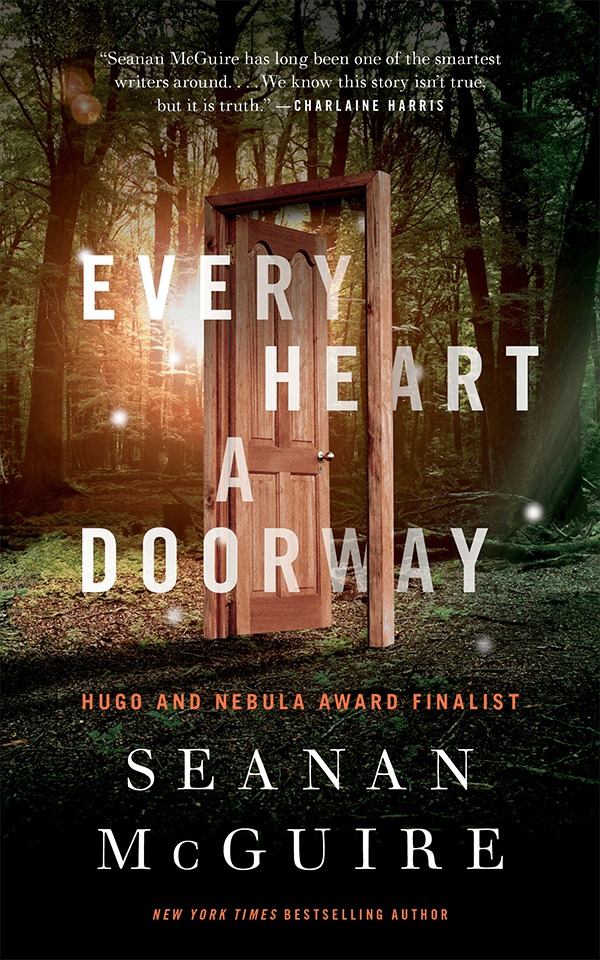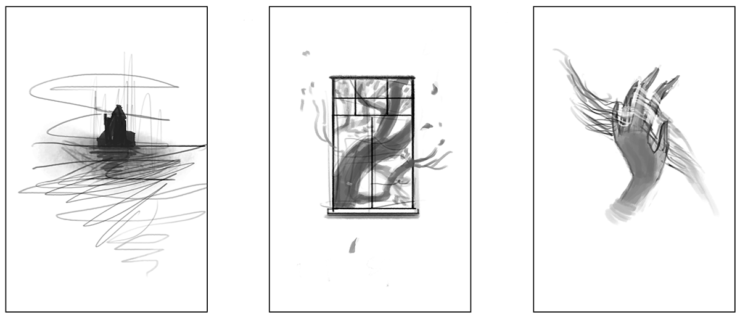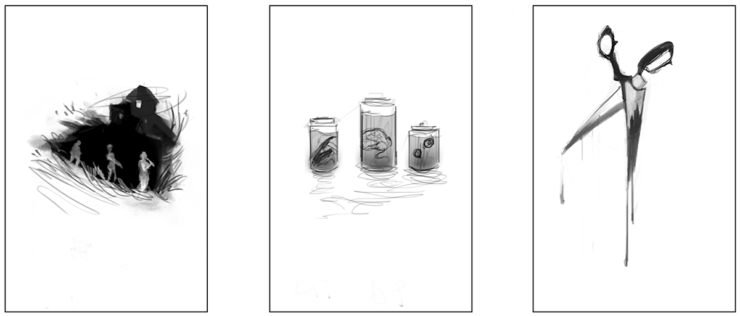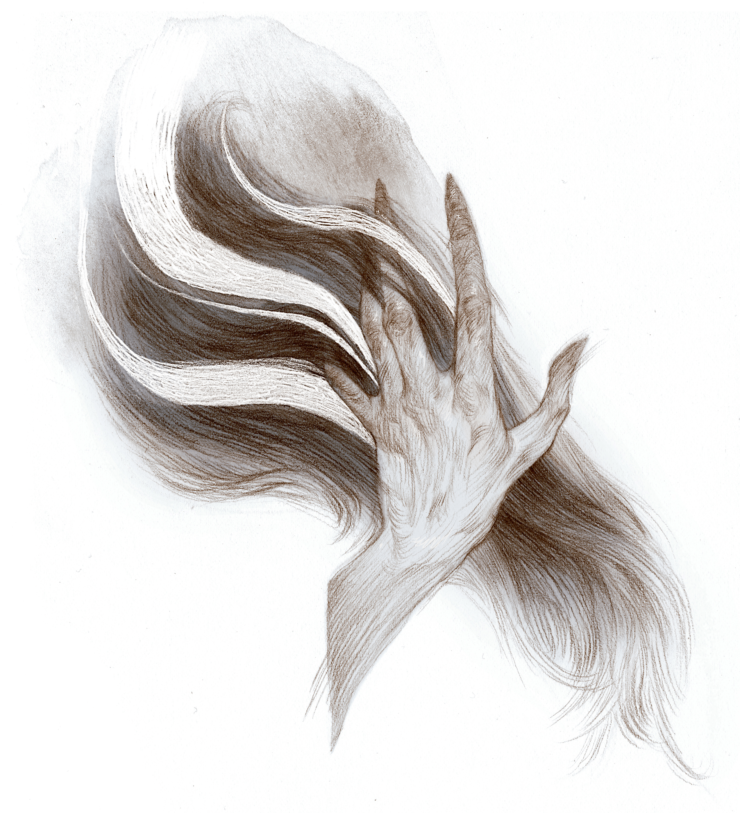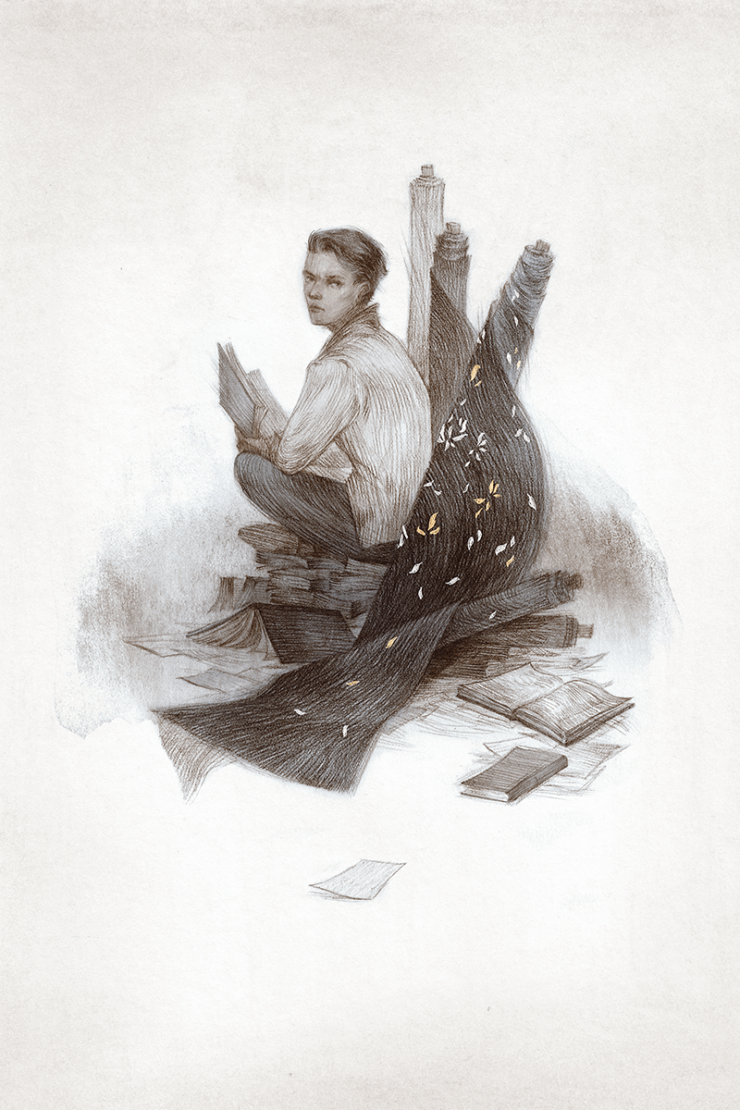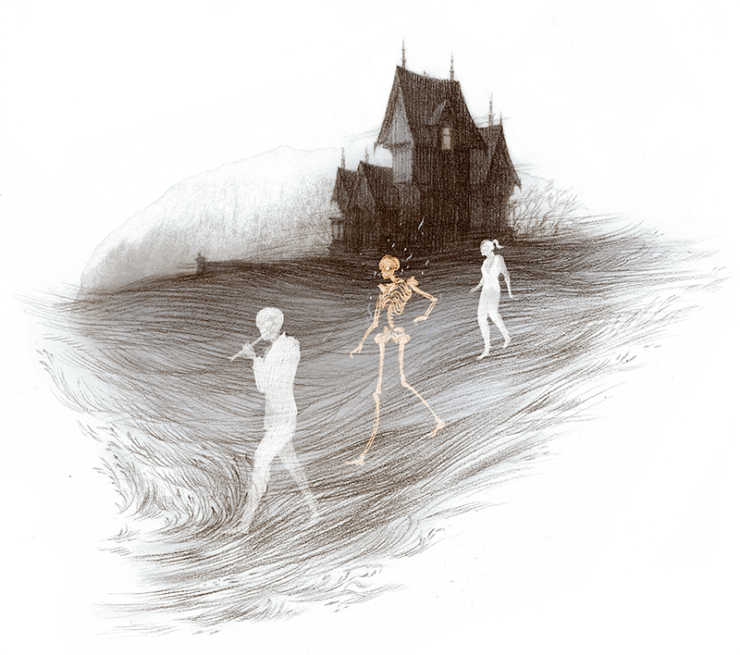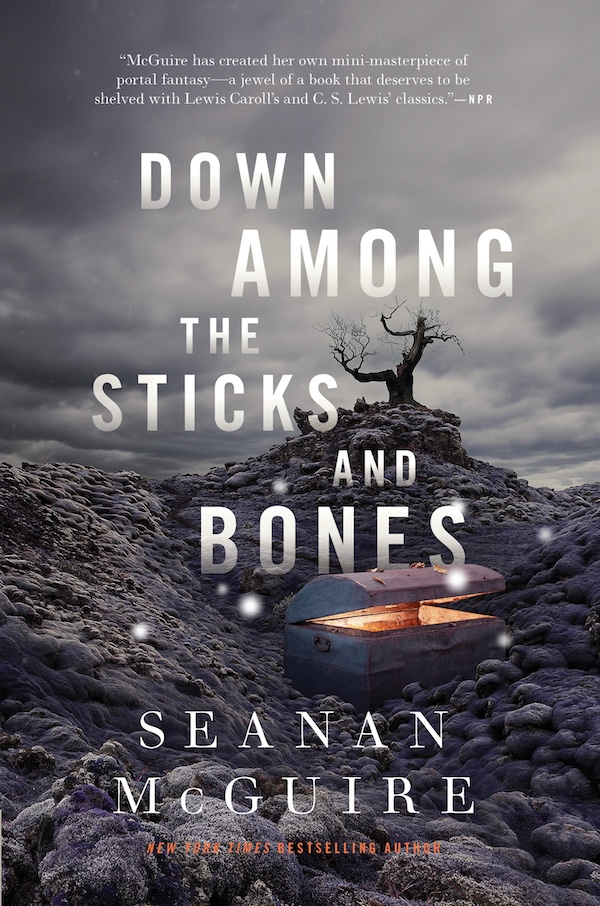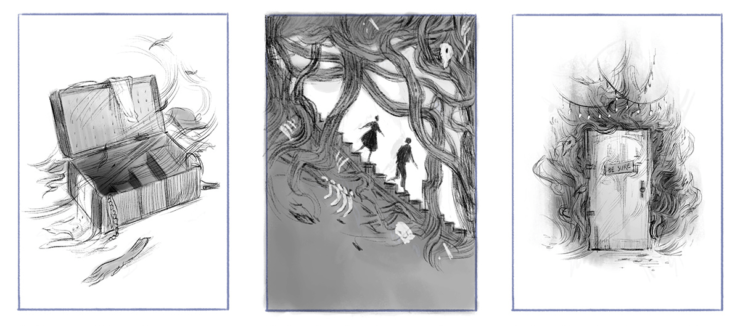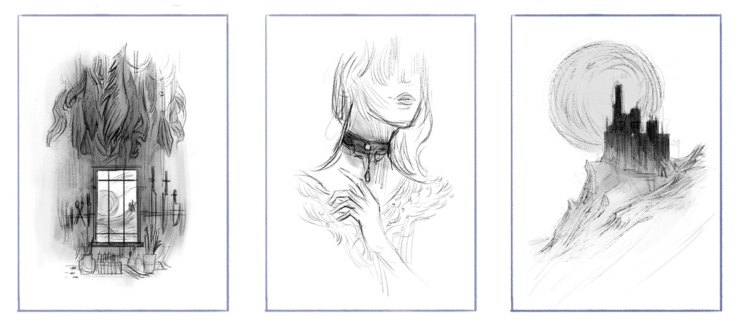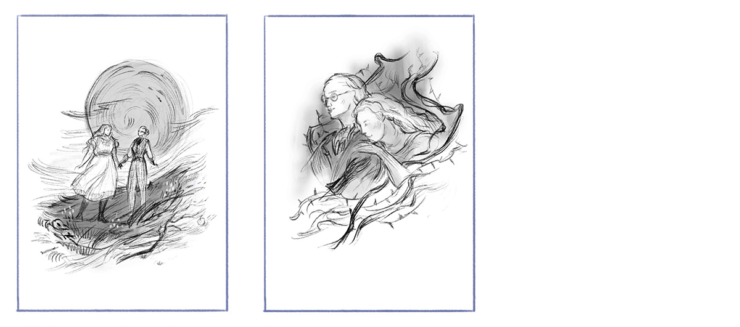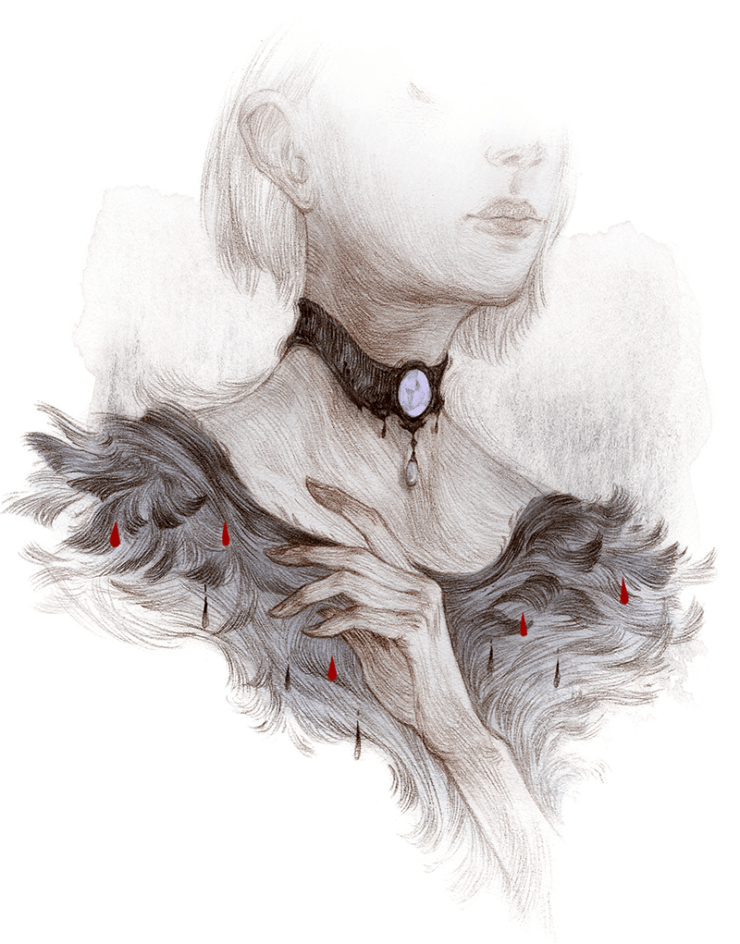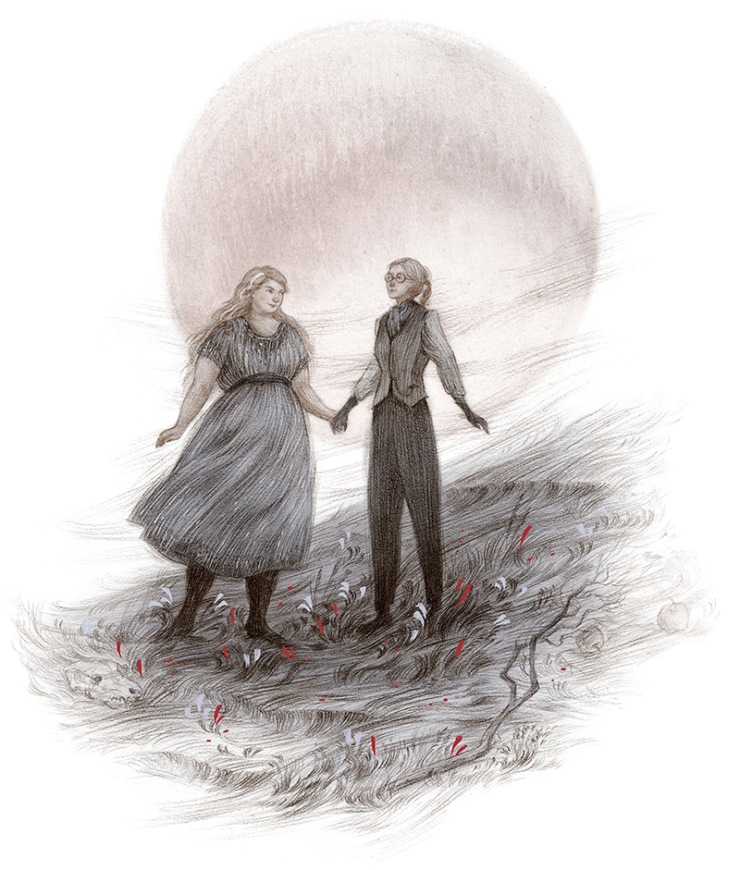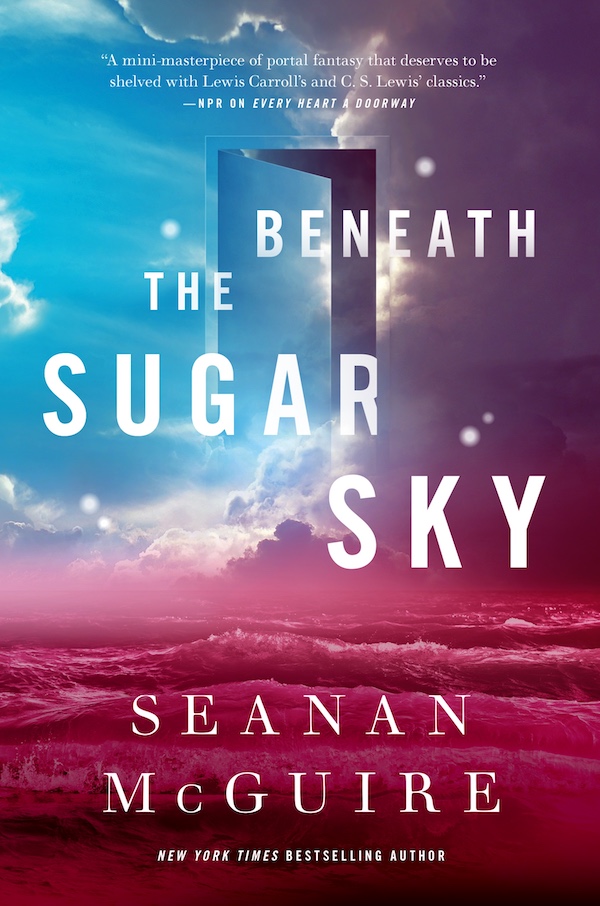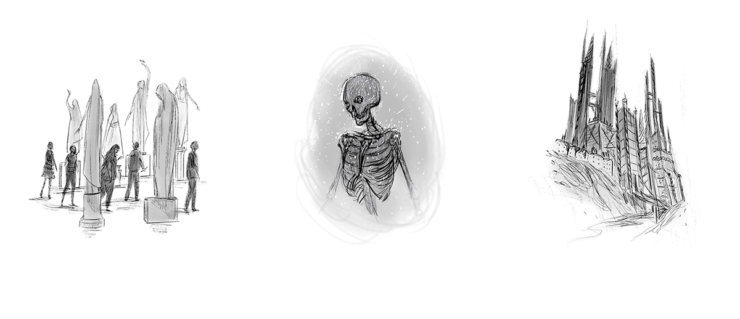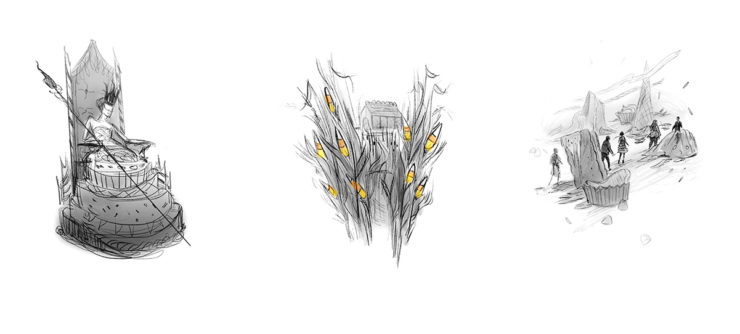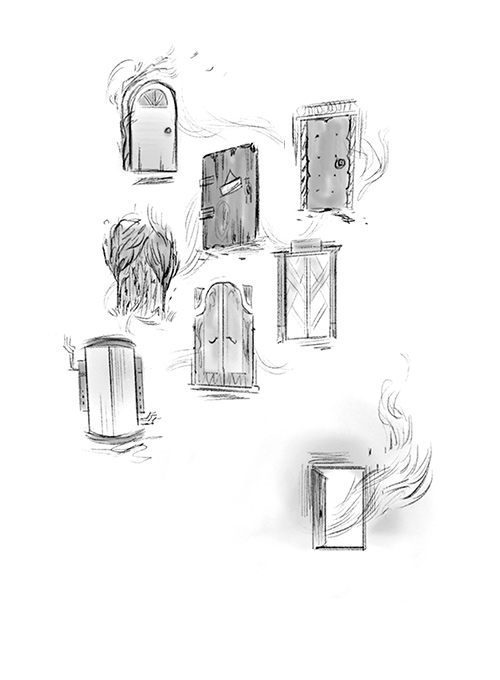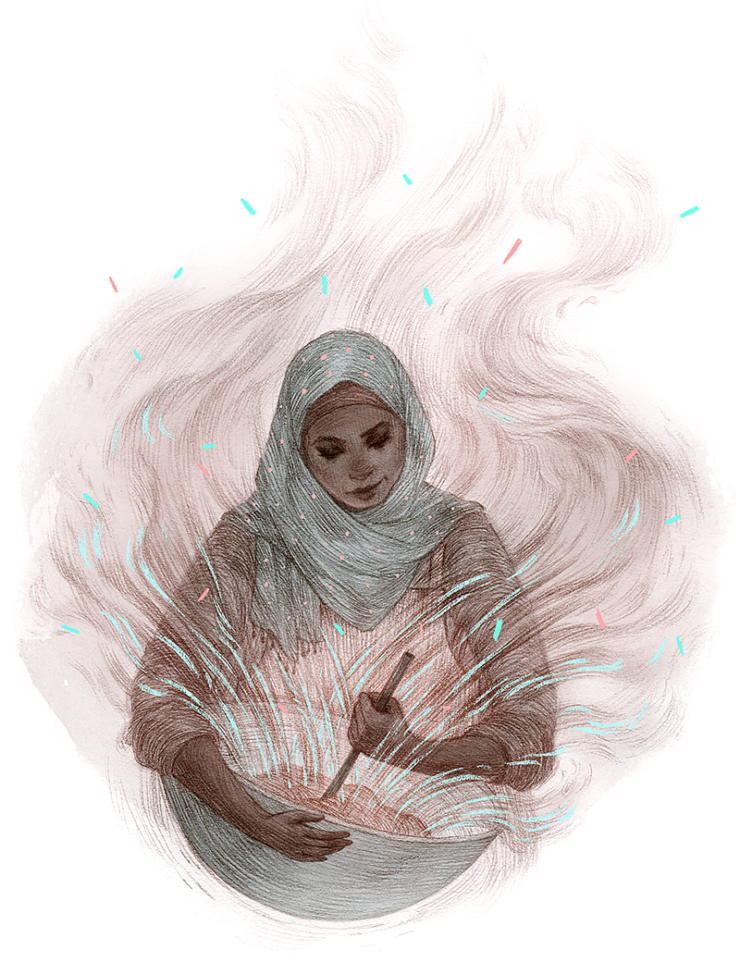Every June, I help teach the Illustration Master Class, an SFF illustration workshop that takes place in Amherst. One of the many perks of taking part in the IMC is getting to choose a few favorite fiction titles to use as class assignments. Two years ago, Seanan McGuire’s Every Heart a Doorway was one of those favorites. I was excited to see what the class would do with it, primarily because I loved the book, but also because we had opted for a photo montage for the cover, rather than an illustration. I was curious what an artist would do with Seanan’s (now Hugo Award-winning) Wayward Children series.
I was also very excited to see that Rovina Cai was going to be an attendee at the IMC that year—I already knew her work from various events and I was a fan. Rather than create a cover for Every Heart a Doorway, Rovina decided to focus on a series of spot illustrations that could be used as chapter openers. It was clear that Rovina got the story. It was heartbreaking (since the book was already in the process of being published) to see so many wonderful moments brought to life in Rovina’s evocative style, which hints at things without ever exposing too much. She sets a mood that’s a little pretty, a little distant, and a lot otherworldly. Perfect for the book.
In fact, I loved Rovina’s sketches so much that, after the class ended, I hired her to finish three of them to use while marketing Every Heart. Since then, I have commissioned her to do three drawings for each of the Wayward Children books—the recently released Down Among the Sticks and Bones, and the upcoming Beneath the Sugar Sky.
When new sketches come in, it’s both a delight and a source of heartache to have to pick only three for each book. The good news is, here we have the space to show off all of Rovina’s sketches. I wish we could include them all in print, but for now, please enjoy Rovina’s unique look through well-hidden doorways into the strange, brilliant, magical, and dangerous worlds beyond.
Sketch #1: Prologue: “The manor sat in the center of what would have been considered a field, had it not been used to frame a private home. The garden grew in a profusion of colors that normally existed together only in a rainbow, or in a child’s toy box.”
Sketch #2: Chapter 1: “Eleanor’s ‘perfect room’ was on the first floor, in the shadow of a great old elm that blocked almost all the light that would otherwise have come in through the single window.”
Sketch #3: Chapter 1: “When I danced with the Lord of the Dead for the first time he said it was beautiful, and he ran his fingers through it. All the hair turned white around them, out of jealousy.”
Sketch #1: Chapter 2: “The furniture appeared to be made from the piles of books, bolts of fabric were piled atop. At the center of it all, cross-legged atop a pedestal of paperbacks, sat the most beautiful boy Nancy had ever seen.”
Sketch #2: Chapter 4: “[Jill] was perched on a tree root, her pale lavender gown arranged to drape just so around her slender frame, a parasol resting against her left shoulder and blocking the sun that filtered down through the branches.”
Sketch #3: Chapter 4: “…her [Sumi’s] hands—her clever, never-still hands—were gone, severed at the wrists. She would never tie another knot or weave another cat’s cradle out of yarn.”
Sketch #1: Chapter 8: “Together, they walked across the property, the girl, the boy, and the dancing skeleton wrapped in rainbows.”
Sketch #2: Chapter 11: “The table she had swept clear was now occupied by an assortment of jars, each with its own, terrible burden.”
Sketch #3: Chapter 11: “…gracelessly, [Jill] collapsed, revealing the scissors sticking out of her back.” The bloodstain on the scissors is in the shape/reflection of a castle in the moors (the world that the twins went to).
A selection was then taken from these thumbnail sketches to detail and refine, resulting in the final illustrations you see in the book.
Final Illustrations (Every Heart a Doorway):
Chapter 1: “When I danced with the Lord of the Dead for the first time he said it was beautiful, and he ran his fingers through it. All the hair turned white around them, out of jealousy.”
Chapter 2: “The furniture appeared to be made from the piles of books, bolts of fabric were piled atop. At the center of it all, cross-legged atop a pedestal of paperbacks, sat the most beautiful boy Nancy had ever seen.”
Chapter 8: “Together, they walked across the property, the girl, the boy, and the dancing skeleton wrapped in rainbows.”
Sketch #1: “The dressup clothes and accessories were gone, all of them, replaced by a winding wooden staircase that descended down, down, down into the darkness…”
Sketch #2: “…down, down, down, down past earthen walls thick with tree roots and, later, with the great white bones of beasts that had walked the Earth so long ago that it might as well have been a fairy tale.”
Sketch #3: “Down, down, down they went, until they stepped off the final stair, into a small, round room with bones and roots embedded in the walls, with dim white lights on strings hanging around the edges of it, like Christmas had been declared early.”
Sketch #1: “Jillian and Jacqueline ran through the flowers like wild things. / The door slammed shut behind them. Neither girl noticed; not yet. They were busy running through the flowers, laughing, under the eye of the vast and bloody moon.”
Sketch #2: “He walked to the head of the table […] Jill sat on his left. Jack moved to sit beside her, and he shook his head, indicating the place on his right. / “If I’m to have a matching pair for three days, I may as well enjoy it,”
Sketch #3: “It seemed very close, and then, as they walked on and on without reaching it, she realized that it was, instead, very large; it was a windmill meant to harness the entire sky.”
Sketch #1: “The ceiling was more than twenty feet overhead, covered with dangling things the likes of which Jack had never seen before […] Racks of tools and shelves laden with strange bottles and stranger implements lined the walls.” (Windmill)
Sketch #2: “Leaning forward, she tied the choker around Jill’s neck. It was tight, but not so tight as to be uncomfortable; Jill thought she would be able to get used to it. And it was beautiful. She didn’t get to wear beautiful things very often.”
Sketch #3: “And yet look to the castle on the bluffs, the castle near to the sea, which sits atop a crumbling cliff in the belly of the lowlands. Look to the castle where the golden-haired girl walks the battlements at dusk and dawn.”
Sketch #1: “They made an odd pair, strolling across the Moors, neither of them looking like they had a care in the world. […] they walked in smooth, matched steps, never turning their ankles, never forcing the other to rush.” (Jack and Alexis)
Sketch #2: “She rested her head against Jack’s shoulder. Jack inhaled, breathing in the salty smell of her lover’s hair, and thought that there was something to be said for worlds of blood and moonlight, where the only threat more terrible than the things that dwelt in the sea were the things that lived on the shore. Beauty was all the brighter against a background of briars.”
Below, see how Rovina Cai’s thumbnail sketches for the windmill, Jill, and Jack and Alexis blossomed into richly detailed illustrations:
Final Illustrations (Down Among the Sticks and Bones):
“It seemed very close, and then, as they walked on and on without reaching it, she realized that it was, instead, very large; it was a windmill meant to harness the entire sky.”
“Leaning forward, she tied the choker around Jill’s neck. It was tight, but not so tight as to be uncomfortable; Jill thought she would be able to get used to it. And it was beautiful. She didn’t get to wear beautiful things very often.”
“They made an odd pair, strolling across the Moors, neither of them looking like they had a care in the world. […] they walked in smooth, matched steps, never turning their ankles, never forcing the other to rush.” (Jack and Alexis)
Sketch #1: “That was when the girl fell out of the sky and landed in the middle of the turtle pond with an enormous splash.”
Sketch #2: “The rest were busy looking at Rini’s left hand, with its two missing fingers. They hadn’t been cut off: there was no scar tissue. She hadn’t been born that way: the place where her fingers should have been was too obviously empty, like a hole in the world.”
Sketch #3: “She came, a lithe, delicate skeleton wrapped in a pearlescent sheen, like opal, like sugar glass. The cemetery gates had been designed to keep the living out, not the dead in; she stepped sideways and slipped right through the bars, her fleshless body fitting perfectly in the gap.”
Sketch #1: “The trees were gone. In their place was a long hall, the sort that belonged in a palace or a museum, its walls lined with statues, all of them standing beautifully still in their frost-white draperies.” (Halls of the Dead. From left to right: Rini, Nadya, Cora, Christopher, and Kade.)
Sketch #2: “Sumi was covered in the dots of light. They clustered on her bones, hundreds of them, with more arriving every second. She was holding up her skeletal hands like she was admiring them, studying the shimmering specks of light that perched on her phalanges. Dots of light had even filled her eye sockets, replacing her empty gaze with something disturbingly vital.”
Sketch #3: “In some ways, the castle that had appeared in front of them was nothing more nor less than a gingerbread house taken to a dramatic new extreme. […] But true as that idea was, it didn’t do justice to the towering edifice of cake and cereal brick and sugar. This was no kitchen-craft […] This was a monument, a landmark, an architectural marvel baked with the sole intent of standing for a thousand years.” (The Queen of Cakes’ castle.)
Sketch #1: “…and there was the Queen of Cakes, a thin, pinch-faced woman in a gown that was also a six-tiered wedding cake, its surface crafted from frosting and edible jewels. […] She was holding a scepter in one hand, a long, elaborate stick of blown sugar and filigreed fondant, matching the crown upon her head.”
Sketch #2: “The fields were a lush green paean to farming, towering stalks reaching for the sky, leaves rustling with such vegetative believability that it wasn’t until Cora blinked that she realized the ears of corn topping each individual stalk were actually individual pieces of candy corn, each the length of her forearm.”
Sketch #3: “Fallen soufflés, pieces of trimmed-off cake, and slabs of cracked fudge were everywhere, heaped into mountains of discarded treats behind a chain link fence of braided fruit vines.” (The Baker’s Junkyard. From left to right: Sumi, Christopher, Rini, Cora, and Kade.)
Sketch #1: “For others, the lure of a world where they fit is too great to escape, and they will spend the rest of their lives rattling at windows and peering at locks, trying to find the way home. Trying to find the one perfect door that can take them there, despite everything, despite the unlikeliness of it all.”
Final Illustrations Thus Far (Beneath The Sugar Sky):
“That was when the girl fell out of the sky and landed in the middle of the turtle pond with an enormous splash.”
“The trees were gone. In their place was a long hall, the sort that belonged in a palace or a museum, its walls lined with statues, all of them standing beautifully still in their frost-white draperies.” (Halls of the Dead. From left to right: Rini, Nadya, Cora, Christopher, and Kade.)
And finally, a new sketch, not initially thumbnailed, of the baker from Beneath the Sugar Sky.











